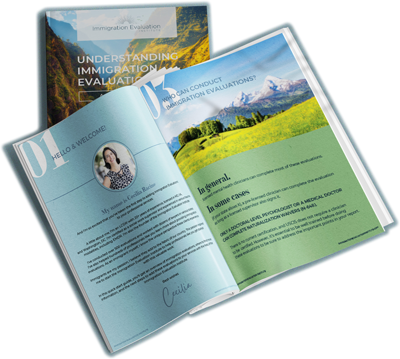What do you want to learn more about?
Ergonomics for Immigration Evaluation Therapists

As immigration evaluation therapists, we not only spend a lot of time seated with our clients, but we also spend significant time at our desks writing.
That’s a lot of sitting.
With many of us now working from home (sometimes in makeshift workspaces), it’s little wonder you may find yourself experiencing a sore back or stiff neck. Thankfully, there are several things you can do, and simple adjustments you can make to your workspace, to help you work more comfortably and minimize strain.
Tips to Adjust Your Workspace
A comfortable workspace can do more than protect your body; it can also motivate you to write those immigration evaluations more quickly! Here are some tips to help make your workspace more ergonomically friendly (Mayo Clinic, 2019).
Get the right chair
Rather than sitting in the flat-backed chairs you may have around your dining table, use an office chair that is designed to support the curve of your spine.
Arrange your mouse and keyboard
Ensure that your mouse and keyboard are on equally level surfaces. They should be positioned such that you can reach them easily when your upper arms are close to your body, and your wrists are straight.
Position your monitor
Your monitor should be directly in front of you, about an arm’s length away. If you use a desktop computer, position your monitor such that it is at or slightly below eye level and directly behind your keyboard. If you primarily work on a laptop, you may find that a laptop stand helps you position your screen at the correct height.
Try a footrest
Sitting with your legs or feet in an incorrect position can put pressure on your back. To overcome this, try getting an ergonomic footrest, and have it at such a height that your feet rest flat upon it, and your thighs are parallel to the floor.
Adjust your desk/table height
Your desk should be tall enough that your knees, thighs, and feet can move freely beneath it. If your desk is too low, elevate it using some sturdy blocks or boards. If it’s too high, raise your chair (and add in that footrest if your feet are no longer touching the floor). Avoid storing things under your desk that may cramp your legs and feet.
Working Ergonomically
Once you’ve got a comfortable workspace, it’s important to check that your own physical position and style of working is ergonomically friendly (Yale Environmental Health & Safety, 2020).
Take regular breaks
Ensure that you change up your position every 25-28 minutes. Once your time is up, stand, stretch, and if you have a standing desk, adjust it to the alternate position for your next block of work.
Keep your chin up
Take note of whether your chin seems to be falling to your chest when you work. If it is, adjust your chair or monitor to avoid putting strain on your head and neck
Rest your eyes
During your breaks, don’t keep looking at your screen. Instead, alternate between focusing your vision on near and far-away objects in the room to minimize eye strain.
Check your posture
One of the easiest ways to improve your seated posture is simply to ensure you are sitting all the way back in your chair. Aim for a 90-degree angle between your legs and back.
Having a more comfortable space to work will help you write better immigration evaluations, so do your clients a favor by setting yourself up for success. By taking small steps to look after yourself, you’ll be in a better position to look after your clients—fewer aches and pains for you means less distraction and more attention to give to your work!
If you’re looking for even more content like this, consider joining the Immigration Therapist Community, where you’ll have access to even more experts like this on a monthly basis, and so much more.
References
Mayo Clinic. (2019). Office ergonomics: Your how-to guide.
Yale Environmental Health & Safety (2020). How to set up your ergonomic home office: Six essential ergonomics tips for remote workers [Fact sheet].

I’m Cecilia Racine, and I teach therapists how to help immigrants through my online courses. As a bilingual immigrant myself, I know the unique perspective that these clients are experiencing. I’ve conducted over 500 evaluations and work with dozens of lawyers in various states. Immigrants are my passion, I believe they add to the fabric of our country.
related articles
Helping Immigrants Find Safety and Healing Through U and T Visas
As mental health clinicians, we possess a unique set of skills that can be a…
Expand Your Expertise: Recommended Trainings for Immigration Clinicians
The Immigration Evaluation Institute Comprehensive course is a great first step into the world of…
Ethical Considerations in Immigration Evaluations
The role of mental health professionals in immigration evaluations is fraught with unique ethical complexities.…
Join the Free
Immigration evaluation
therapists facebook group
Are you a therapist that conducts immigration evaluations?



